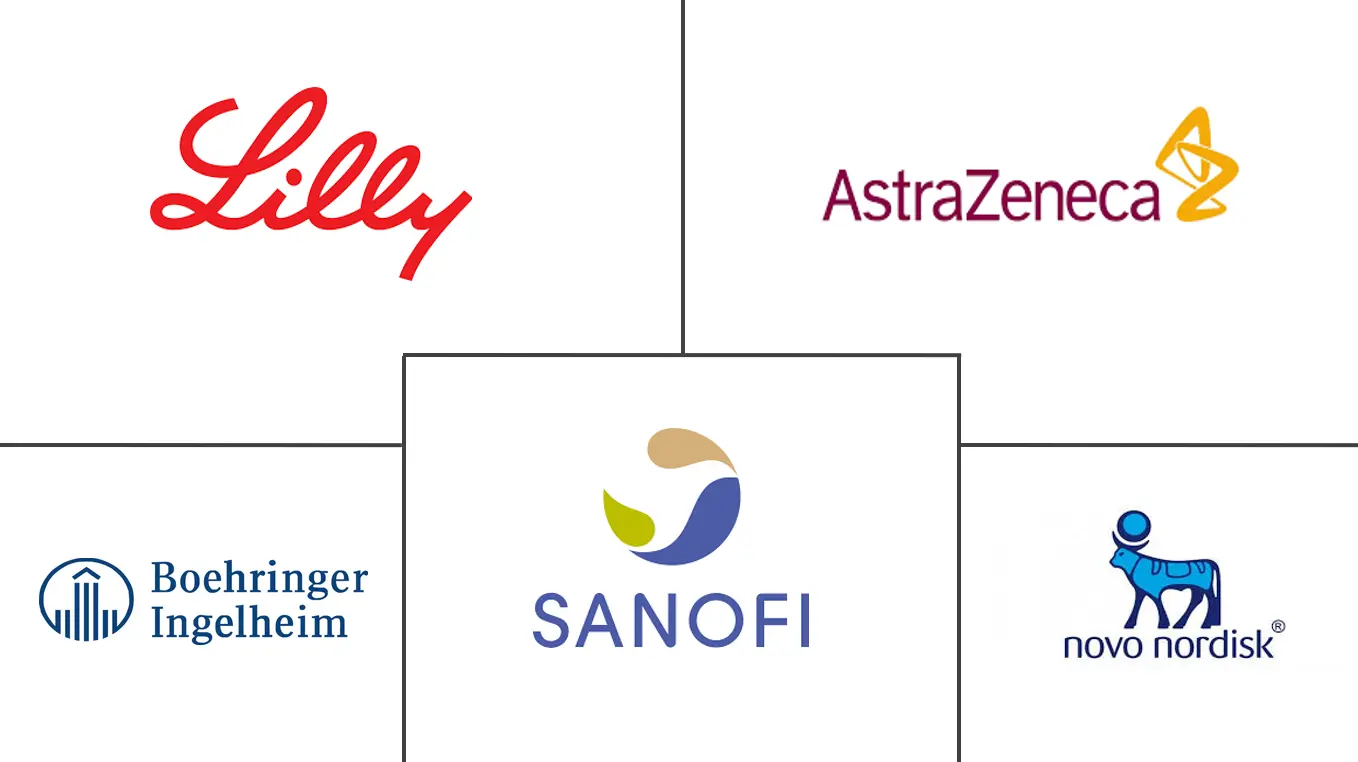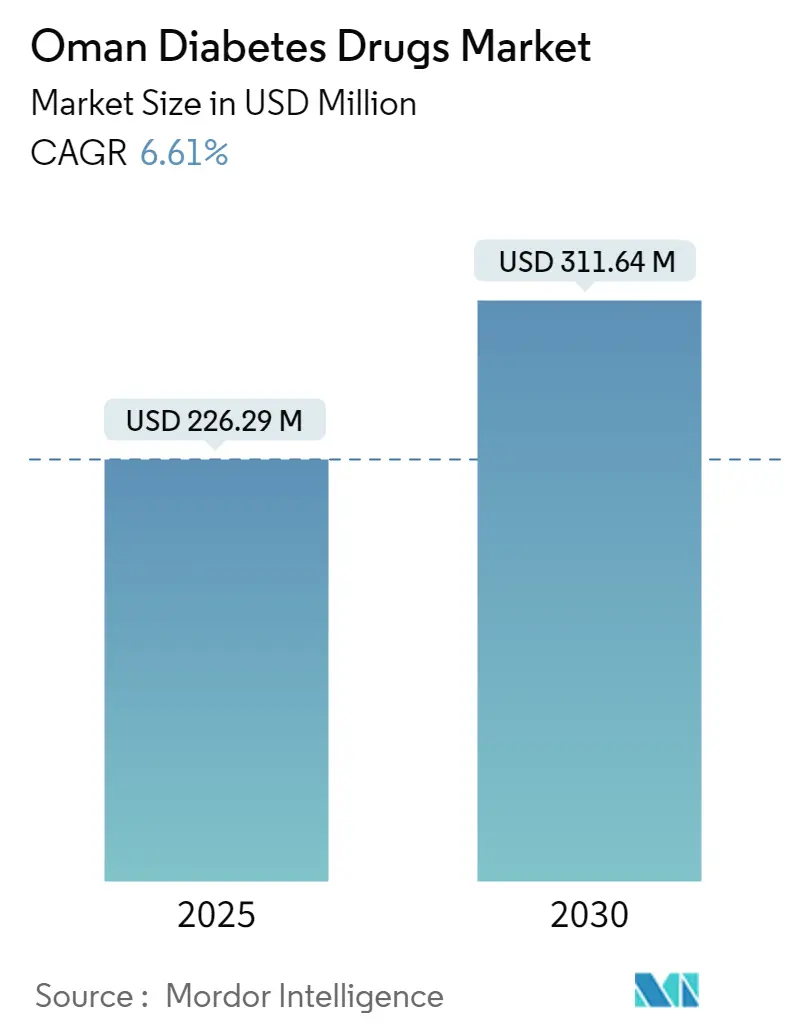
Oman Diabetes Drugs Market Analysis by Mordor Intelligence
The Oman Diabetes Drugs Market size is estimated at USD 226.29 million in 2025, and is expected to reach USD 311.64 million by 2030, at a CAGR of 6.61% during the forecast period (2025-2030).
Diabetic drugs are medicines developed to stabilize and control blood glucose levels amongst people with diabetes. Diabetic drugs are commonly used to manage diabetes. Diabetic drugs have been potential candidates for treating diabetic patients affected by SARS-CoV-2 infection during the COVID-19 pandemic. Although the current numbers show that the existence of diabetes is comparatively lesser in Oman, the growth rate of the diabetic population is projected to be higher in the country.
According to Mordor Intelligence, the diabetic population in Oman is expected to reach 0.84 million by 2027. Diabetes is associated with many health complications. Patients with diabetes require many corrections throughout the day to maintain nominal blood glucose levels, such as administering additional insulin or ingesting additional carbohydrates by monitoring their blood glucose levels. Diabetes poses an emerging healthcare burden across the country and is one of the leading causes of premature death, morbidity, and loss of economic growth.
Oman, Ministry of Health, recently participated in the virtual launch of the WHO Global Diabetes Compact, organized jointly by the World Health Organization and the government of Canada aimed at raising awareness level about diabetes as a global disease, in addition to expanding prevention and treatment as part of primary health care and universal health coverage.
Therefore, owing to the aforementioned factors the studied market is anticipated to witness growth over the analysis period.
Oman Diabetes Drugs Market Trends and Insights
The oral anti-diabetic drugs segment holds the highest market share in the Oman Diabetes Drugs Market in the current year
The oral anti-diabetic drugs segment holds the highest market share of about 88.8% in the Oman Diabetes Drugs Market in the current year.
Oral Anti-Diabetic Drugs are available internationally and are recommended for use when escalation of treatment for type 2 diabetes is required along with lifestyle management. Oral agents are typically the first medications used in treating type 2 diabetes due to their wide range of efficacy, safety, and mechanisms of action.
Anti-diabetic drugs help diabetes patients control their condition and lower the risk of diabetes complications. People with diabetes may need to take anti-diabetic drugs for their whole lives to control their blood glucose levels and avoid hypoglycemia and hyperglycemia. Oral anti-diabetic agents present the advantages of easier management and lower cost. So they became an attractive alternative to insulin with better acceptance, which enhances adherence to the treatment.
In July 2022, Zydus Lifesciences announced that it had received final approval to market Empagliflozin and Metformin Hydrochloride tablets in multiple strengths. Empagliflozin and Metformin Hydrochloride tablets are used with proper diet and exercise to improve glycemic control in adults with type 2 diabetes mellitus. They are also used to lower the risk of cardiovascular death in patients with type 2 diabetes mellitus and established cardiovascular disease.
According to Oman Diabetes Association, diabetes is a costly chronic illness that needs control of blood sugar levels. It imposes a challenge for low-income and social security patients. Thus, an initiative is designed to reduce the burden on these targeted groups, consequently promoting sugar control. Moreover, the number of new cases among children is about 60 annually. According to local studies and reports on good diabetes control, the rate in adult patients ranges from 32-35%, whereas it reaches 10-12% among children and adolescents. The Government is working on increasing awareness of diabetes and access to medicines to improve good diabetes control.
Owing to the rising rate of obesity, growing genetic factors for type-2 diabetes, the increasing prevalence, and the factors above, the market will likely continue to grow.
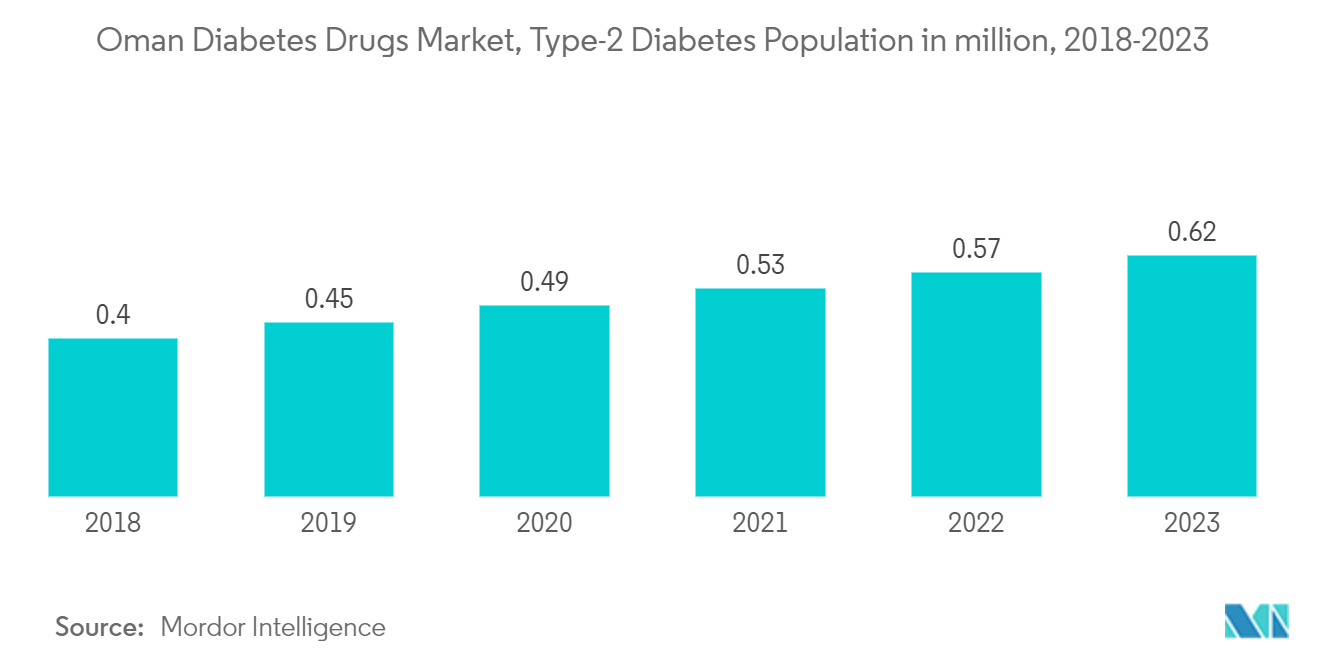
Metformin is expected to dominate the Oman Diabetes Drugs Market over the forecast period
Metformin is expected to dominate the Oman Diabetes Drugs Market and register a CAGR of around 6.1% over the forecast period.
Biguanides are a class of medications used to treat type 2 diabetes. They work by reducing the production of glucose that occurs during digestion. Metformin is the only biguanide currently available in most countries for treating diabetes. Glucophage (metformin) and Glucophage XR (metformin extended release) are well-known brand names for these drugs. Others include Fortamet, Glumetza, and Riomet. Metformin is also available in combination with several other types of diabetes medications, such as sulfonylureas.
Diabetes reduces lifespan, and people with the disease are likely to experience blindness and be hospitalized for amputations, kidney failure, heart attacks, strokes, and heart failure. Metformin is the first-line choice for the management of hyperglycemia in T2DM. Besides being an important glucose-lowering agent, metformin also includes significant anti-inflammatory properties. Other options must be considered when metformin is contraindicated or not tolerated or when treatment goals are not achieved after three months of use at the maximum tolerated dose. Dipeptidyl peptidase-4 inhibitors, sodium-glucose cotransporter-2 inhibitors, and glucagon-like peptide-1 agonists are generally used to supplement treatment with metformin.
The Ministry of Health, Oman is strategically planning to contain the growing burden of diabetes and invest in all means to control it, stating, 'Our work needs to ensure equitable and affordable access to treatment, and it is essential that we advocate for investments in diabetes education and prevention programs.' Risk factors such as insufficient physical activity and the consumption of unhealthy diets are contributing to the development and progression of the disease.
Owing to the factors above, the market is expected to grow during the forecast period.
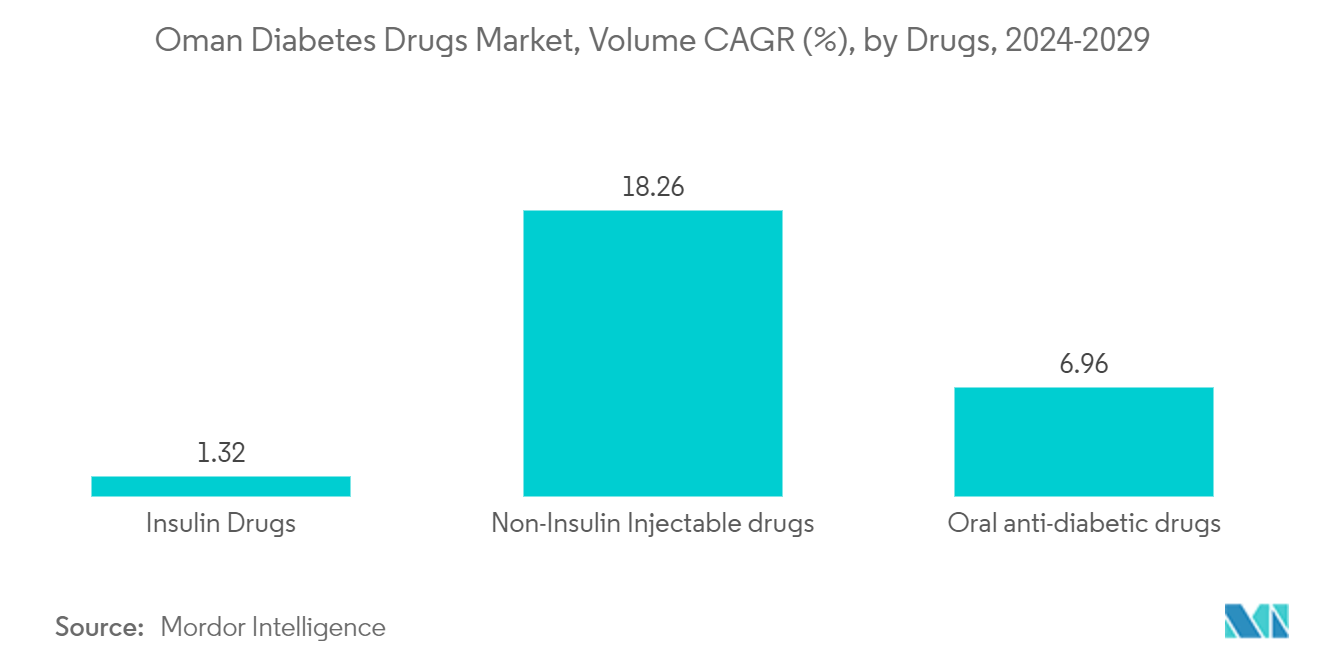
Competitive Landscape
The Oman Diabetes Drugs Market is consolidated, with major manufacturers, namely Eli Lilly, Sanofi, Novo Nordisk, AstraZeneca, and other generic players, holding a presence in the region. A major share of the market is held by manufacturers concomitant with strategy-based M&A operations and constantly entering the market to generate new revenue streams and boost existing ones.
Oman Diabetes Drugs Industry Leaders
AstraZeneca
Boehringer Ingelheim
Novo Nordisk A/S
Sanofi Aventis
Eli Lilly and Company
- *Disclaimer: Major Players sorted in no particular order
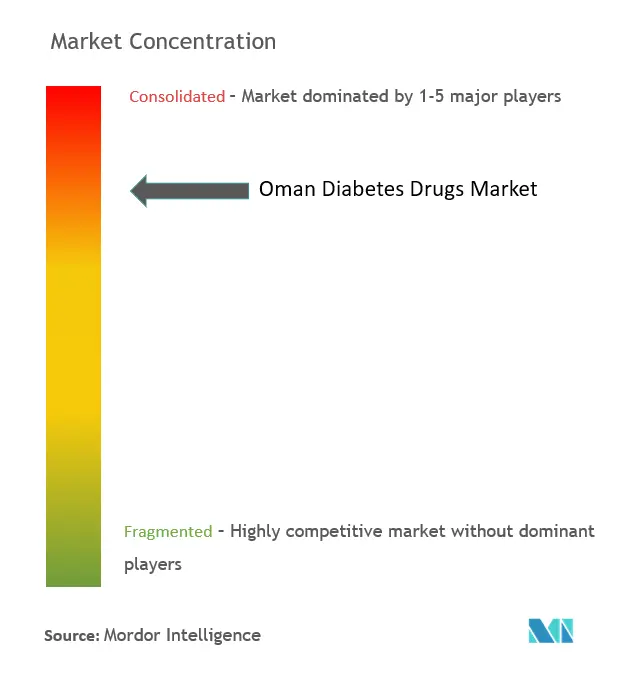
Recent Industry Developments
- November 2023: Novo Nordisk's initiation of a Phase III comparative trial for their pipeline drug CagriSema against the recently approved Zepbound suggests the potential for direct competition between the two drugs upon Novo Nordisk's candidate entering the market.
- October 2022: The Ministry of Industry and Advanced Technology announced the signing of a pair of memoranda of understanding worth AED 260 million (USD 70.8 million) between major pharmaceutical and medical device companies in the UAE. The partnerships align with the National Strategy for Industry and Advanced Technology and the ICV Program. It aims to attract investors and manufacturers to the UAE's pharmaceutical and medical equipment sectors. Under a separate MoU, PureHealth, and Gulf Pharmaceutical Industries Company will establish the first factory in the Middle East to produce Glargine to treat diabetes.
Oman Diabetes Drugs Market Report Scope
Diabetes Drugs are used to manage diabetes mellitus by lowering the glucose level in the blood. The Oman Diabetes Drugs Market is segmented into drugs. The report offers the value (in USD) and volume (in Units) for the above segments.
| Basal or Long Acting Insulins | Lantus (Insulin Glargine) |
| Levemir (Insulin Detemir) | |
| Toujeo (Insulin Glargine) | |
| Tresiba (Insulin Degludec) | |
| Basaglar (Insulin Glargine) | |
| Bolus or Fast Acting Insulins | NovoRapid/Novolog (Insulin Aspart) |
| Humalog (Insulin Lispro) | |
| Apidra (Insulin Glulisine) | |
| Traditional Human Insulins | Novolin/Actrapid/Insulatard |
| Humulin | |
| Insuman | |
| Biosimilar Insulins | Insulin Glargine Biosimilars |
| Human Insulin Biosimilars |
| Biguanides | Metformin |
| Alpha-Glucosidase Inhibitors | Alpha-Glucosidase Inhibitors |
| Dopamine D2 receptor agonist | Bromocriptin |
| SGLT-2 inhibitors | Invokana (Canagliflozin) |
| Jardiance (Empagliflozin) | |
| Farxiga/Forxiga (Dapagliflozin) | |
| Suglat (Ipragliflozin) | |
| DPP-4 inhibitors | Onglyza (Saxagliptin) |
| Tradjenta (Linagliptin) | |
| Vipidia/Nesina(Alogliptin) | |
| Galvus (Vildagliptin) | |
| Sulfonylureas | Sulfonylureas |
| Meglitinides | Meglitinides |
| GLP-1 receptor agonists | Victoza (Liraglutide) |
| Byetta (Exenatide) | |
| Bydureon (Exenatide) | |
| Trulicity (Dulaglutide) | |
| Lyxumia (Lixisenatide) | |
| Amylin Analogue | Symlin (Pramlintide) |
| Insulin combinations | NovoMix (Biphasic Insulin Aspart) |
| Ryzodeg (Insulin Degludec and Insulin Aspart) | |
| Xultophy (Insulin Degludec and Liraglutide) | |
| Oral Combinations | Janumet (Sitagliptin and Metformin) |
| Insulins | Basal or Long Acting Insulins | Lantus (Insulin Glargine) |
| Levemir (Insulin Detemir) | ||
| Toujeo (Insulin Glargine) | ||
| Tresiba (Insulin Degludec) | ||
| Basaglar (Insulin Glargine) | ||
| Bolus or Fast Acting Insulins | NovoRapid/Novolog (Insulin Aspart) | |
| Humalog (Insulin Lispro) | ||
| Apidra (Insulin Glulisine) | ||
| Traditional Human Insulins | Novolin/Actrapid/Insulatard | |
| Humulin | ||
| Insuman | ||
| Biosimilar Insulins | Insulin Glargine Biosimilars | |
| Human Insulin Biosimilars | ||
| Oral Anti-diabetic drugs | Biguanides | Metformin |
| Alpha-Glucosidase Inhibitors | Alpha-Glucosidase Inhibitors | |
| Dopamine D2 receptor agonist | Bromocriptin | |
| SGLT-2 inhibitors | Invokana (Canagliflozin) | |
| Jardiance (Empagliflozin) | ||
| Farxiga/Forxiga (Dapagliflozin) | ||
| Suglat (Ipragliflozin) | ||
| DPP-4 inhibitors | Onglyza (Saxagliptin) | |
| Tradjenta (Linagliptin) | ||
| Vipidia/Nesina(Alogliptin) | ||
| Galvus (Vildagliptin) | ||
| Sulfonylureas | Sulfonylureas | |
| Meglitinides | Meglitinides | |
| Non-Insulin Injectable drugs | GLP-1 receptor agonists | Victoza (Liraglutide) |
| Byetta (Exenatide) | ||
| Bydureon (Exenatide) | ||
| Trulicity (Dulaglutide) | ||
| Lyxumia (Lixisenatide) | ||
| Amylin Analogue | Symlin (Pramlintide) | |
| Combination drugs | Insulin combinations | NovoMix (Biphasic Insulin Aspart) |
| Ryzodeg (Insulin Degludec and Insulin Aspart) | ||
| Xultophy (Insulin Degludec and Liraglutide) | ||
| Oral Combinations | Janumet (Sitagliptin and Metformin) | |
Key Questions Answered in the Report
How big is the Oman Diabetes Drugs Market?
The Oman Diabetes Drugs Market size is expected to reach USD 226.29 million in 2025 and grow at a CAGR of 6.61% to reach USD 311.64 million by 2030.
What is the current Oman Diabetes Drugs Market size?
In 2025, the Oman Diabetes Drugs Market size is expected to reach USD 226.29 million.
Who are the key players in Oman Diabetes Drugs Market?
AstraZeneca, Boehringer Ingelheim, Novo Nordisk A/S, Sanofi Aventis and Eli Lilly and Company are the major companies operating in the Oman Diabetes Drugs Market.
What years does this Oman Diabetes Drugs Market cover, and what was the market size in 2024?
In 2024, the Oman Diabetes Drugs Market size was estimated at USD 211.33 million. The report covers the Oman Diabetes Drugs Market historical market size for years: 2019, 2020, 2021, 2022, 2023 and 2024. The report also forecasts the Oman Diabetes Drugs Market size for years: 2025, 2026, 2027, 2028, 2029 and 2030.
Page last updated on:
Oman Diabetes Drugs Market Report
Statistics for the 2025 Oman Diabetes Drugs market share, size and revenue growth rate, created by Mordor Intelligence™ Industry Reports. Oman Diabetes Drugs analysis includes a market forecast outlook for 2025 to 2030 and historical overview. Get a sample of this industry analysis as a free report PDF download.
